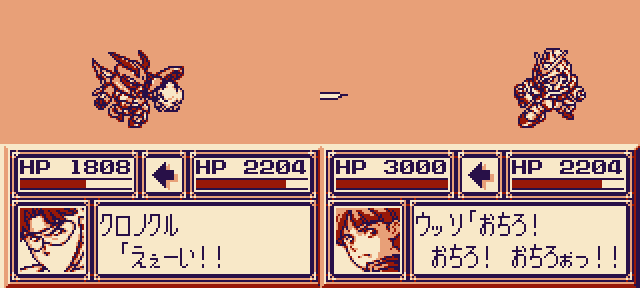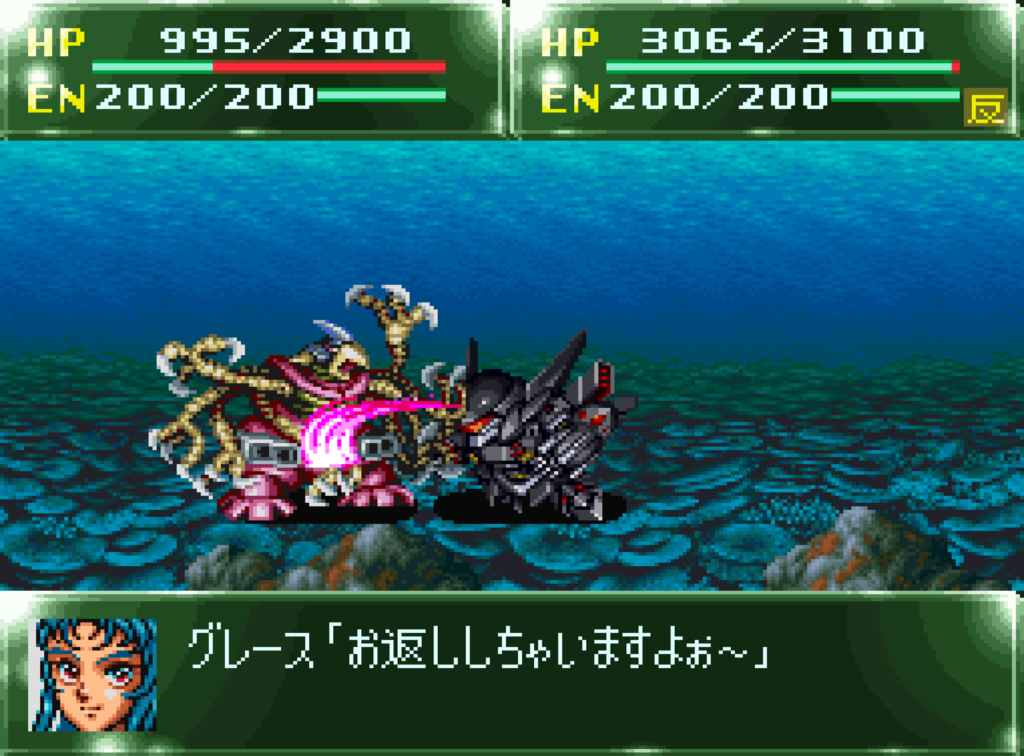One of my goals is to have every entry in my SRPG game table lead to a post, even if it’s a remake or port. Sometimes I will just link to the main post if all I need to say is “The Saturn version has slightly different graphics and one bonus map”, but if it’s a more extensive remake I will make a separate post or mini-post for it.
This post will cover four Super Robot Taisen games that I passed over or that will occur later this year. As usual I’m mostly copying things that I wrote many years ago when I played the games, but I didn’t write much for any of these games so I added some additional notes.
Super Robot Taisen 2G (Gather), Game Boy 6/30/1995
Here’s what I wrote about this game many years ago:
After 4, the SRW franchise entered a period of uncertainty and confusion, primarily caused by the console wars at the time. The situation was very comparable to what SRW is going through now [That is, in the transition from PS2 to the next gen consoles]. There were a lot of remakes, original character games, games for established portable systems, and false starts as the series felt around for a new direction.
The next game after 4 was a remake of 2 for Game Boy, which came only three months after 4’s release. Despite being a remake, it contains a lot of new things. V Gundam and G Gundam both premiere in this game — G Gundam ended three months before the release of 2G, so these series really were on the cutting edge of mecha anime at the time. In terms of gameplay, the system is basically the 4 system, minus the equippable items. This game also has the first instance of the Full Upgrade Bonus system (where upgrading all of a units stats to full will let you add an additional upgrade bonus)
The story presents itself as the “true chronicle” of the 2nd SRW (the NES game being the official federation version). However, it doesn’t fit in with the established continuity because Tetsuya and Ryuune both appear in this game. The story writing is much more advanced than the NES version; more like 4.

The game is not especially good, though, and it looks like I didn’t take any real notes when I played it 15 years ago.
Super Robot Taisen 4S (Scramble), Playstation, 1/16/1996
Five months after 2G, the next remake came out. This is notable as the first game for a disc system, and the first game for what would eventually become Banpresto’s dominant console for SRW. 4S is essentially a straight remake of 4; there are a couple of new stages and some bug fixes, but overall it’s the same game.
Probably the most notable thing about it is the introduction of voices. This is the first SRW game to have any kind of voice acting — however, it’s only for the heroes. Supposedly some of the voice clips recorded for 4S are still used in games today [That is, in 2008]. (Shiozawa Kaneto died after F/FF came out so it’s good he was able to contribute his voice to these older games).
At the time when I was writing these old posts, I did not have a computer that was capable of running a PSX emulator and I didn’t want to import this game so I didn’t play it — a few days ago I did play a bit of the first stage; the graphics are identical to the Super Famicom.

I wonder if this is the version of the game you would want to play if language weren’t an issue — the load times are obviously worse than SFC but it does have the voicing.
Shin was after this, which I posted about earlier.
Super Robot Taisen F and F Final, Saturn 12/25/1997(F), 4/13/1998(FF) PSX 12/10/1998(F), 4/15/1999(FF)
The next step after Shin was to switch platforms over to the Sega Saturn; apparently Banpresto was trying to strike some sort of merger or deal with Sega. The resulting game had a rather tumultuous history. According to Wikipedia, it was originally intended to be a sequel to Shin. But Sega wanted them to use their established chronology, so they decided to remake 4 instead. The letter F could be interpreted to stand for “Fifth” or “Final”. However, the production took so long that the game had to be split into two. Finally, whatever negotiations were going on between Sega and Bandai broke down, and thus the game was later ported to the Playstation. (This was a relatively inactive time for SRW — in two and a half years, F/FF was the only game that came out.)
It really wasn’t so much a “remake” of 4 as a completely new game that used the 4 originals and very broad plot outlines. 4 series were removed, all old Super Robot shows (Grendizer, Raideen, Daimos, Zambot 3). The new additions were Evangelion, Ideon, Gunbuster, Gundam Wing, and G Gundam. (Wing and G had of course appeared before, although Wing just in cameo. Endless Waltz is in FF, but only in the Wing Zero Custom and Tallgeese III.) For Evangelion, there was even some scripting done by Hideaki Anno (the scene where Bright slaps Shinji).
Systemwise, the game is similar to Shin, although the “healing = xp” thing is brought in from Masou Kishin. In addition, the map items are gone and you now get items from defeating enemies. One major development is the splitting of “luck” into one seishin that doubles XP and one that doubles money. Finally, the “love” system was added in this game where you can have two units near each other (e.g. Sayaka and Kouji) for their stats to increase. This was not in the manual or strategy guides, though, and there’s no display of the change on the screen, so the effect can only be seen by testing and comparison.
The graphics are back the old-style SD graphics. Compared to Shin, they are kind of a step backwards to the old “sliding sprites” model, and they’re way behind the times, as may be expected from a port that comes out a year later than the original game. The portraits are worse than Shin in that they often only show the face, not the head, and it can be hard to tell even what a person is supposed to look like (Gato’s portrait, for instance, doesn’t show his hair at all). However, they do incorporate the multiple portraits showing emotions that was introduced in Masou Kishin. (Speaking of MK, the MK characters get their own themes in this game, carried over from MK:LoE.)

[I did not write stage-by-stage updates for this game because I did a walkthrough for GameFAQs, for each game.]
Overall, it’s a decent game. The story is a step up from what’s been in previous SRW in the development of the characters and the amount of dialogue — however, the dialogue is still mostly oriented towards explaining the next battle; there’s little of the character interaction (particularly of minor characters) that develops in later SRWs. The difficulty level is fairly high, although I don’t think it’s as hard as 4. The main problem with the game is its length. The split into two parts resulted in a lot of unecessary padding; I think the game could have been reduced by 25-30 stages and still kept essentially the same story. Also given that you can’t skip battle animations, playing the game becomes very tedious. The final stage is also kind of dumb; ending it with Zezenan might have felt more fulfilling.
Super Robot Taisen Complete Box, released 6/10/1999
This game is much later than where I am now, but it makes sense to put it here so that I can refer to the post later. This was a remake of Super Robot Taisen 2, 3, and EX. It was done by reusing the assets from 4S and F/FF, and standardizing the gameplay of all three titles to that of F and FF. The biggest changes were made to 2 because of how different 2 was from the later games; the plot is the same but the maps are somewhat different.

—
The next SRW game was in 1999 so it will be a while before we see it again.